13.3 Quality control of information
|
Previous
Chapter 12: E-communications
|
 CHAPTER OVERVIEW
CHAPTER OVERVIEW
| Unit 13.1 | Defining the task |
| Unit 13.2 | Finding information |
| Unit 13.3 | Quality control of information |
| Unit 13.4 | Spreadsheets and databases in data handling |
| Unit 13.5 | Processing data |
| Unit 13.6 | Analysing data and information |
 By the end of this chapter, you will be able to:
By the end of this chapter, you will be able to:
- Create a task definition
- Gather data and information using various tools
- Describe how to evaluate data to ensure that it is reliable and accurate
- Discuss how to evaluate the validity of a website as a source of information
- Evaluate information for accuracy and validity
- Describe the role of spreadsheets and databases in data handling
- Discuss tools and techniques for data handling and how to extract data
- Describe how to analyse trends and patterns in data
INTRODUCTION
Data is all around us and we create data with our every action, both online and in the real world. Data can be used in various industries to draw many insights into the way people shop, travel and interact with companies, brands and other people.
The process of collecting, processing and presenting data and information is called information management and consists of three main steps:
1.Input: This is the first step of the information management process, consisting of the identification of the main problems and collecting relevant data.
2.Process and analyse: Once all the data has been gathered, it is converted to information by processing and analysing the data.
3.Output: This is the final step in the process and consists of presenting the information in such a way that it can be easily understood by other people.
Solving problems successfully or completing work on time largely depends on your ability to find, process and present the correct information. Before you start looking for information, though, you will need to work through your task to make sure that you understand it fully and that you know what information you need and where to find it. You can do this by following the steps in the information cycle shown in Figure 13.1.
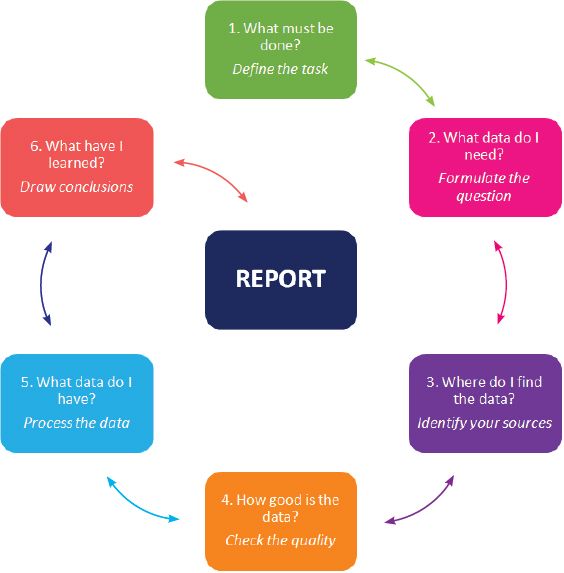
You need to keep in mind that the order of this cycle is not set in stone and you may need to go back to refine or redo previous steps, but the further along in the cycle you get, the harder it is to go back and do earlier steps. This is why it is important that you do steps one and two as well as possible before moving on.
If you do not have the right information, you will not be able to solve your problem or complete your task properly, be it completing your PAT or even writing this textbook.
In this section, we are going to focus on the following steps of the cycle:
1.Defining the task
2.Formulating the questions
3.Identifying and evaluating questions, information and information sources (such as websites)
4.Analysing and processing the data
UNIT
13.1 Defining the task
It may seem obvious but before you can successfully complete any task or investigation, you need to understand exactly what it is that you are going to do. This is why you need to carefully consider the task you have been given by breaking it down into smaller sections and describing it in your own words, called the task definition.
To understand what is expected of you, you must do the following:
1.Read the instructions. Does the task call for a report? How will you gather the information?
2.Rewrite the question in your own words. Get to the core of the question. Rewriting helps you understand exactly what you need to do so that you do not waste time looking for the wrong data. It also helps you decide what type of data you need and how to gather it.
3.Identify the key terms. Look for verbs or subject-specific terms in the task (verbs like “report back” give guidelines on how you should present information).
DEFINING THE TASK
Look at the image below, taken from the 2018 PAT.
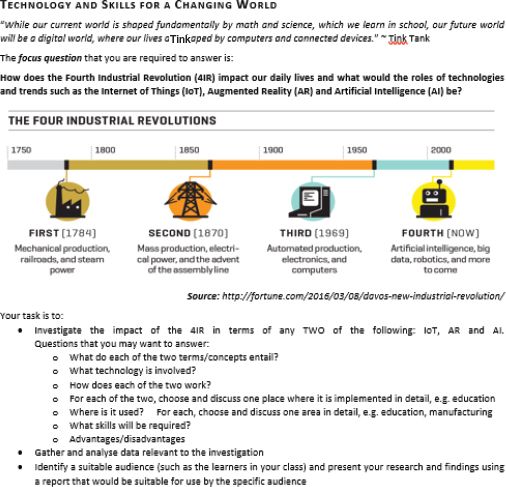
Looking at the task outline, you can begin to define what you need to do. In this case, you would need to choose two technologies from the Fourth Industrial Revolution (4IR) and investigate their impact on modern life.
The task outlines various questions you can ask yourself to further refine your search for information. You are then instructed to gather the data and analyse it and, finally, to present your findings in a report. With this information, you will be able to start your research.

Something to know
Your PAT task description should be about 200 words.
To understand how important it is to make sure that you know what you are being asked to do, read through the scenario below.
UNDERSTANDING TASKS
Julia, Mbali and Shiven are on the organising committee for the Grade 12 dance. They have each been given a task to complete to better help the organisers understand what the Grade 12s want:
- Julia has been asked to find out how many Grade 12s would be interested in bringing a partner from outside the school to the dance and to give a report to the teacher supervisor, Mr Smith.
- Mbali has been asked to find out what theme the Grade 12s want for the dance so that she can let the decorating committee know what they need to buy.
- Shiven has been asked to find out about the music.
Julia begins by breaking down her task. She decides that the best way to go about gathering the information is through an online survey. She first has to design the survey and then distribute it. She decides to use Google Forms for her survey and sends the link to the Grade 12 WhatsApp group. She asks people to please fill in her survey by Friday. Once she has this information, she downloads the report that Google Forms generates and gives it to Mr Smith.
Mbali also decides to break down her task but immediately runs into a problem. She has no clear idea of what the decorating committee is willing to spend on decor and they have not given her suggestions for themes. Mbali realises that if she were to ask the Grade 12s what theme they would want, she would end up with a different response for each person.
Mbali will need to get more information before she can complete her task. She decides to ask the decorating committee the following questions:
- Are there any theme suggestions?
- Is there a budget and how does that limit the theme?
The decorating committee tells her that they have three theme ideas. Now that she has this information, she can define her task. She decides a simple survey will also help her get the information the decorating committee needs.
Shiven’s task is too vague. He will need to get more information on the following:
- Is the school willing to pay for a band or DJ? Or should he ask for a learner volunteer?
- Will there be sound equipment available or will the performers need to provide their own?
- What kind of music do the Grade 12s want at the dance?
- What kind of music will the school not allow?
Only when he has this information, will he be able to define his task and give the appropriate solution.
 Activity 13.1
Activity 13.1
Define a task definition and a focus question for the 2018PAT.
UNIT
13.2 Finding information
INFORMATION-GATHERING TOOLS
After you have identified the task definition, you will have to gather data and information. In this phase, you must consult different types of information sources to understand the subject of your investigation better.
Information can be gathered using the following tools:
- Electronically: internet
- Printed media
- Surveys and questionnaires
 Activity 13.2
Activity 13.2
Using the task definition you created in Activity 13.1, answer the following questions to determine how you will research the topic and obtain the information you need for the task you defined.
1.Which type of information gathering tools will you use?
2.Identify at least two websites on the subject that you can use to compare your findings against.
3.Develop a questionnaire with 10 questions that you can use to obtain school-specific information.
4.How will you assess that the information you get is accurate, sufficient, valid, current and objective?
5.Discuss your work with another group and compare results.
UNIT
13.3 Quality control of information
A large majority of the content on the World Wide Web is user-generated, meaning it is created by people of any age, educational background and experience. This means that when you are using the WWW to research your PAT, you will need to carefully evaluate the information you find. In this chapter, you will learn about how to evaluate information to make sure that it is reliable and accurate.
EVALUATE QUESTIONS
When you are looking for the data you need to complete your task, you can ask yourself questions to guide you. There are two main types of questions, namely open-ended and closed-ended questions.
Closed-ended questions have a limited set of possible answers, such as “yes”, “no” or “A”, while open-ended questions need more complex answers. You should not make the mistake of thinking that closed-ended questions are simple. Some closed-ended questions, for example “Are amoebas single-celled organisms?” have a specific answer, but not everyone can answer them.
While both types of questions are good for gathering data, closed-ended questions are only useful in the early stages of the data gathering process when you are trying to find as much data related to your topic as possible. This is because they put an end to the conversation. Closed-ended questions are good for surveys or where your respondents do not have the time to spend thinking about their answers.
When using closed-ended questions for research, ask yourself: “Does this data match my topic?” If it does, make a note of it, if it does not, discard it. You will then use open-ended questions to refine the data further and make sure that what you have found helps you complete your task.
In order to refine your data using open-ended questions, you need to decide what type of open-ended questions you will ask. There are several types of open-ended questions, for example:
- Questions that can be answered explicitly by facts, for example, questions starting with words such as “what”, “when”, “where”, “who”, or “how many”.
- Questions that will help you to examine, explore and query, such as questions starting with “why” and “how”.
- Questions that will help you to adjust, change or predict, such as questions starting with “if”, or “what if”.
- Questions that will help you to make a judgment, critique, review or find meaning of some sort, such as questions starting with “would it be better if”, “what recommendation”, “how can I determine”, or “what would be the best way”.
- Open-ended questions allow you to get more from the data than you anticipated when you use these questions to interrogate that data.
You can also use a combination of open-ended and closed-ended questions in questionnaires. You will most likely be asked to create a questionnaire for your PAT, so knowing how to ask these questions when you are researching will help you to set them when the time comes.
Tips for asking questions:
- Always start an open question with “how” or with questions beginning with “w”: “what”, “where”, “when”, “which” or “who”.
- Try to avoid “why” questions, because human nature leads people to make up a rational reason even when they don’t have one. If you want to get more information, rather say “please tell me more about that”.
- Do not start with “was” or forms of the verbs “to be” and “to do”.
- Try to get the person you are asking a question to tell a story, rather than giving one- or two-word answers.
- If you cannot avoid asking a closed-ended question, follow it up with an open-ended question such as “what else can you tell me about it”.
- You can get an open-ended answer from a multiple-choice question if you add “other” as an option.
EVALUATE INFORMATION SOURCES
Once you have defined your task, you can begin to gather your data and put it together to turn it into information. To do this you will need to know what types of questions to ask to get the information you need, as well as evaluate the quality of the information and the websites where you find it.
EVALUATE WEBSITES
When you are doing research online, it is important to think about the websites you are using. Not all websites are created equal and many may contain misleading, or even false, information. Much as you evaluate the quality of the information you receive, you must also evaluate the quality of the websites you visit and use.
There are some key questions you can ask yourself about the websites you are visiting and using, for example:
- Who supports this website?
- Who is this website aimed at?
- Who is the author? What are their credentials?
- How is the content organised? Do all the links on the pages work?
- How easy is it to navigate around the website? Is the design pleasing and attractive? How quickly does the site load?
- What is the grammar and spelling like?
- Is the content objective or does it support a single opinion?

Something to know
Low-quality websites might not only give you bad information, they could also be a way for malicious software such as viruses, spyware or malware to get onto your computer.
These are all important questions to ask when looking at a website. Let us look at each point in detail to understand why you should ask these questions.
- Authority: Look at the web address of the website. The domain name can help you determine if the information has been published by a credible source, for example .ac says that it is published by a university, .gov refers to the government, etc.
- Look for the author’s name. If they choose to remain anonymous, ask yourself why. A quick Google search will also show you if they have any qualifications in the field they are writing about. This is especially important in scientific or technical articles, since you would want an expert telling you how to do something or explaining something to you.
- The grammar and spelling on the site are also extremely important. If a website is filled with grammar and spelling errors, it may not be the most authoritative or authentic source for the information you are looking for.
- Affiliation and objectivity: You should always be aware of who owns or financially supports it. This could be a good indicator of whether there will be bias in the information. Take a close look at the content and try to work out if it is biased or supports one opinion too heavily. Biased content is the opposite of high-quality content, as it has a very narrow view on a subject.
- Try to use websites supported by, or linked to, established institutions such as government agencies, non-profit organisations or educational institutions. Remember, objective sites present information with a minimum of bias.
- Audience: You should also make sure that the website’s target audience (the people it is aiming its content at) is appropriate for your needs. A website aimed at young children will not help a university student with their research, while a website aimed at giving information to doctors will not help an engineer in their research. Make sure that the content you are looking at is appropriate for your needs.
- Content: Another important thing to look at is how the content of the website is arranged. Does it make sense or is the information scattered all over the place? Is it easy to find what you are looking for or do you have to spend ages trying to figure out the website’s navigation? Also check to see if all the links work, in articles and on the website itself. Broken links are often a sign of a badly maintained or spammy website.
- Currency and design: Is the website designed well and does it look professional? If not, this could be a sign that the website is old and outdated or just badly designed, which could mean that the information you find there will be the same. Apart from being very frustrating, websites that load slowly are often badly designed. This could be an indicator of badly written or inaccurate information.
EVALUATE INFORMATION
It is most likely that your primary source of information will be the internet. Understanding the quality of information is important, since the internet is a place where anyone can upload information or make claims. You will need to look carefully at the information you use to discuss the task. You should look at the source of the information and try to find out who has an interest in this data (this is especially important when it comes to scientific papers). You should also think about what people will gain by spreading certain types of information on the internet.
There are five key things that determine the quality of information:
- Authority: This is based on who created the information. If the video you are watching was not created by someone with knowledge in the field, then the information they are giving you might not be the best out there. Always do research on the people who give you information. Authority also indicates that the information is accurate.
- Accuracy: Look for how complete the information is and compare the information from one source against the information from a few others. If the facts match, you can be fairly sure that the information is accurate. Make sure that there is something backing up the facts you receive. Check the source of those facts as well.
- Currency: Check how current the information is. More up-to-date information tends to be more accurate. A technology blog from 2010 will be less relevant, and therefore less accurate, to your research than one from 2017. Information from the last ten years is seen as current.
- Objectivity: Make sure that the author is being objective. Look out for information that is sponsored by a company (that is, if it is a type of long-form advertisement called a sponsored post). This information may be biased towards the facts that the sponsor wants to represent to make their product or information seem like the best.
- Relevance: Lastly, look at how well the information covers the topic you are researching. If the information only covers a small portion of the topic, then it is possibly not the best information to use. You need to look for information that answers about 80% of any question you are trying to find the answer for.
Once you understand how to evaluate the quality of information, you can be confident that you will present your information accurately and reliably.
 Activity 13.3
Activity 13.3
Answer the following questions in your own words.
1.What are the key questions to ask when evaluating a website?
2.Why must you evaluate information?
3.What are the five key things that determine the quality of information?
4.Determine if the following questions are open-ended or closed-ended. Change the closed-ended questions into open-ended questions.
a.Is it hot outside?
b.Have you already completed your homework?
c.How does this make you feel?
d.Do you have plans for the December holidays?
e.What are your plans for when you finish school?
f.Do you like that person?
g.How do you book tickets for a flight?
h.Is that your final answer?
i.Are you satisfied with the results?
j.Did you know that…?
UNIT
13.4 Spreadsheets and databases in data handling
Spreadsheets are documents that have numbered rows and lettered columns that structure data. Examples of spreadsheet software include Microsoft Excel, Google Sheets, LibreOffice Calc and iWork Numbers. You can use spreadsheets to manipulate and organise raw data before putting it in a database, as well as to:
- Do mathematical calculations (adding totals, working out averages and percentages, etc.)
- Display data using charts and graphs
- Define and refine data by breaking it down or splitting it (for example, taking a single row and column of data and splitting it into many columns using a function)
Spreadsheets can also be used as a modelling tool, that is, you can use them to predict trends. As an example, if a company wants to find out what would happen if it reduced the price of one of its products, it could use a spreadsheet to analyse the changes to its profit margins.
Databases, on the other hand, can do exactly what a spreadsheet can, but with more data, since spreadsheets are limited in the amount of data they can hold. Databases are also usually kept on a server, so they can use the bigger processing power of the server to do large and complex procedures and calculations with the data faster than a spreadsheet can.
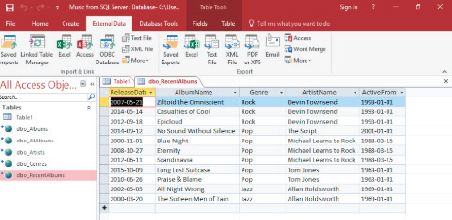
Databases can also better analyse and connect data than spreadsheets, which makes it easier for users to search for, and extract information from, the data. Databases are also designed to connect data more easily across multiple tables.
However, other than the amount of data and the speed of processing, databases and spreadsheets are very similar. In fact, most reports are generated in a database and then exported to a spreadsheet to be displayed. Some website databases need data to be uploaded in spreadsheets saved in a special format called comma separated values (*.csv).
 Activity 13.4
Activity 13.4
Answer the following questions in your own words.
1.What is the main difference between a database and a spreadsheet?
2.When will you use a database rather than a spreadsheet?
3.What is data handling?
4.Give three examples of what you can use spreadsheets for.
5.What can databases do better than spreadsheets?
UNIT
13.5 Processing data
You need to process data or manipulate raw data to draw information from it, that is, you need to crawl through and analyse the data to draw the most relevant/appropriate information from the data.
There are several techniques or tools you can use to do this. These will be discussed below.
TOOLS AND TECHNIQUES
Manipulating data is the process of sorting, arranging or moving the data without changing it. To manipulate data, you should first keep the following in mind:
- You need to know the features of the programs you are using and how to use them.
- Make sure that the data is in the correct format for what you need to do. If it is not, you will need to reformat it or export it into the most appropriate format.
- You might have to use more than one tool to process the data correctly.
- The tools you can use include sorting, formulae and functions and queries. Sorting changes the order of the data. It can be done to numerical data (sorting numbers from lowest to highest) or strings (sorting text alphabetically). This is mostly done in spreadsheets.
 Guided Activity 13.1
Guided Activity 13.1
This is an important function to use in Excel as you might want to arrange data alphabetically, from highest to lowest, or order it by colour or icon. This will help you to visualise and understand your data better.
You can, for example, sort text from A to Z or Z to A, numbers from smallest to largest or vice versa, and dates from oldest to newest, or newest to oldest. You can also sort according to your own custom list or format.
1.To sort text:
a.Select a cell in the column you want to sort.
b.On the Data tab, in the Sort & Filter group, do one of the following:
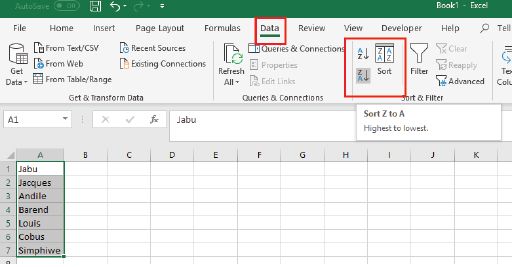
- To quick sort in ascending order, click
 (Sort A to Z).
(Sort A to Z). - To quick sort in descending order, click
 (Sort Z to A).
(Sort Z to A).
2.To sort numbers:
a.Follow steps one and two above.
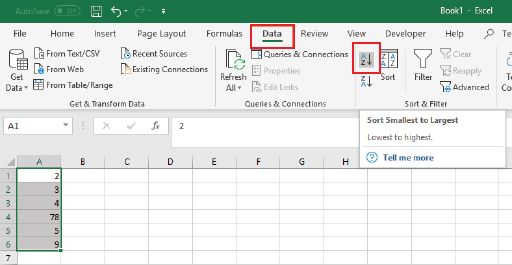
- To sort from low to high, click
 (Sort Smallest to Largest).
(Sort Smallest to Largest). - To sort from high to low, click
 (Sort Largest to Smallest).
(Sort Largest to Smallest).
3.To sort dates and time:
a.Follow the same procedures as above.
4.To sort more than one row or column:
a.Select any cell in the data range.
Note: For the best results, the range of cells that you sort should have column headings.
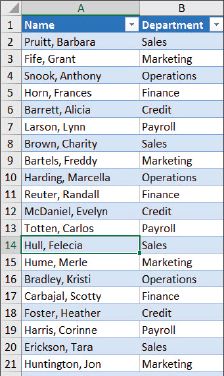
b.On the Data tab, in the Sort & Filter group, click Sort.
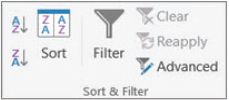
c.In the Sort dialog box, under Column, in the Sort by box, select the first column that you want to sort.
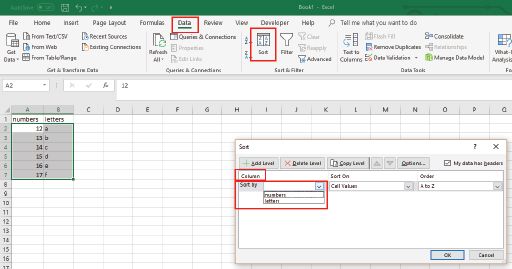
d.Under Sort On, select the type of sort. Do one of the following:
i.To sort by text, number, or date and time, select Values.
ii.To sort by format, select Cell Color, Font Color, or Cell Icon.
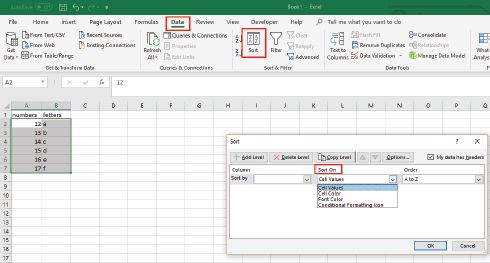
e.Under Order, select how you want to sort. Do one of the following:
i.For text values, select A to Z or Z to A.
ii.For number values, select Smallest to Largest or Largest to Smallest.
iii.For date or time values, select Oldest to Newest or Newest to Oldest.
iv.To sort based on a custom list, select Custom List.
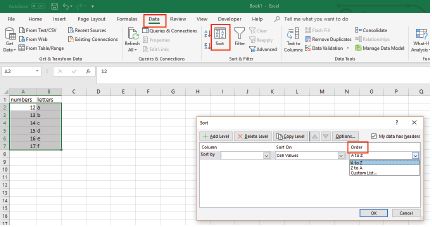
f.To add another column to sort by, click Add Level, then repeat steps c. to e.
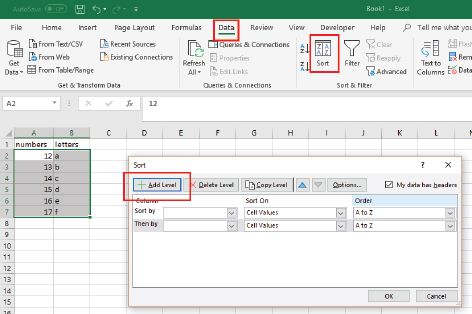
You can also use the various formulae and functions in a spreadsheet program (such as Microsoft Excel) to help you process data. You will have seen most of the functions in action in your practical lessons on Excel; but a list of functions is included below:
- SUM calculates the total of a range of numbers.
- AVERAGE gives the average of a range of values.
- MIN returns the minimum value in a list of values.
- MAX returns the maximum value in a list of values.
- COUNT counts the numbers in a list of values.
- COUNTIF is used for counting cells within a specified range that meet a certain condition.

Something to know
Remember, all formulas begin with an = sign in Excel.
These functions let you interpret large sets of data but are not very good for visualising the data. You can use charts and graphs to visualise data and analyse trends.
EXTRACTING APPROPRIATE INFORMATION
Within spreadsheets and databases, there are various tools and commands you can use to extract information, for example, for a big data set, you can use VLOOKUP in Excel.
To see how extracting information is different using Microsoft Excel and Microsoft Access, look at the case study below.
 Case Study Extracting information
Case Study Extracting information
Mrs Dlamini is the administrative assistant at a school. The head of department for English has asked her to find the yearly average English mark for all Grade 11 learners for the previous year. The spreadsheet Mrs Dlamini is given contains the English marks for every assessment and assignment for every learner in Grade 10, Grade 11 and Grade 12.
So how would Mrs Dlamini find the information?
First, she will need to look at the data she has. When she does this, she sees that the columns have a learner ID number, their full names, grade, class number and terms one, two, three and four marks (as you can see in Figure 13.3).
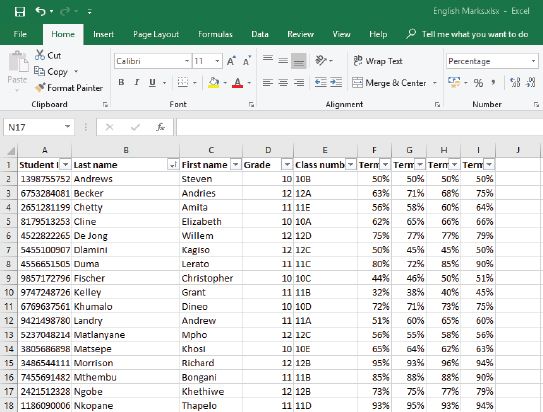
Because this spreadsheet is sorted alphabetically, it is hard to tell which learner is in which grade. In Excel, Mrs Dlamini would need to use the filters on the columns to sort the learners by grade (column D) and then only display the Grade 11 learners. She would then have to use the Average function to work out each student’s average mark for the year in column J. At the bottom of the data in column J, she would then need to use the Average function again to work out the yearly average for Grade 11.
If this spreadsheet was in a database, with the exact same headings and information, Mrs Dlamini would only need to use a single query to do exactly what she did on the spreadsheet.
UNIT
13.6 Analysing data and information
After you have collected your data and formatted it, you will need to analyse your results and compare them to a question. But how do you do this? The best way to support or disprove your question is to look at trends and patterns. This section looks at how to verify and validate your data, how to add data questions to your data to help analyse it and how to analyse for trends and patterns.
ADDING DATA QUESTIONS
Once you have verified your data, you can begin to apply the data questions to it so that you can categorise and organise the data. As you learned in Grade 10, the data questions are:
- How many?
- What is most popular?
- What is least common?
- How many more than?
- What is the average?
TRENDS AND PATTERNS
The final step in data analysis is to look for trends and patterns. While these may seem like the same thing, they are not. Trends are the general tendency of data to move in one direction over time. In a trend, the data points may vary slightly, but they all still move in the same direction.
Think of global temperatures. We all know that the temperature of the Earth is getting higher each year, in fact, scientists have been recording and comparing surface temperatures on Earth for the last 100 years. Looking at this data, we can see that while there have been some very hot and very cold days, the overall trend for global temperatures is up. You can see this in the graph in Figure 13.4.
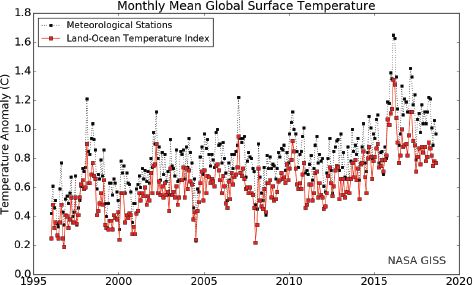
This type of trend is known as an upward trend.
Another type of trend is known as downward trend or downtrend. This happens when the data points move down, for example, the cost of computers and computing technology has decreased since the start of the computer age. If you look at the cost of the first home computers in the 1980s and compare that cost over time to now, you will see that the prices have come down.
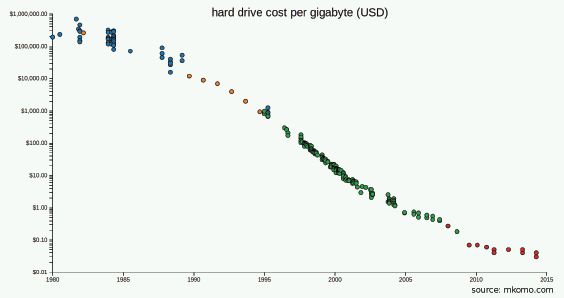
You may also see a link between the cost of computing devices going down while their processing power and speed goes up as the technology improves over time. This is called a correlation trend.
Unlike upward or downward trends, which happen slowly over time, step changes show a massive increase or decrease in the trend. Think of the price of petrol, which can increase or decrease slowly or suddenly jump up or down depending on how much oil costs.
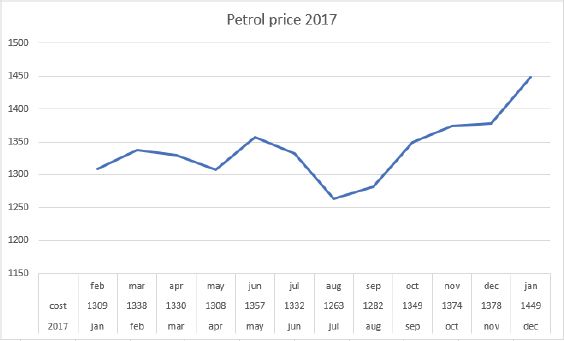
Other trends include daily and seasonal cycles.
Patterns are a little different. Data does not always move up or down over time. Data can also repeat itself in a predictable way or form a shape when placed in a graph. This type of data pattern is usually described in terms of its features, like centred, spread or shape. Table 13.1 describes these patterns and gives an example of each.
Table 13.1: Data pattern types
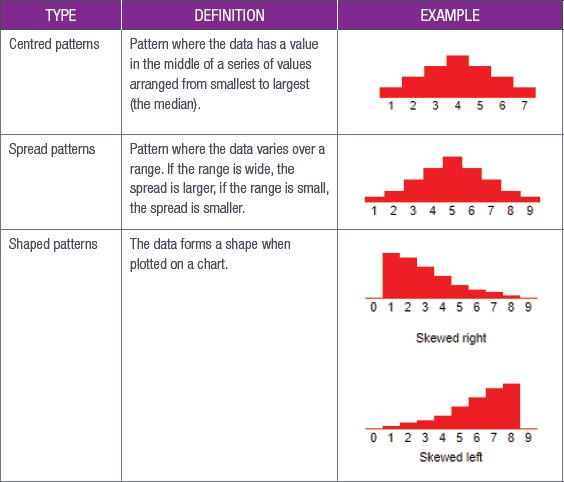
 Activity 13.5
Activity 13.5
Answer the following questions in your own words.
1.What is data verification?
2.Why do you use data verification?
3.Name four data validation techniques, describe how they work and give an example of each.
4.What are two main types of data entry mistakes?
5.Give three examples of trends and how they would be displayed in a report.
6.When analysing data, what is a “pattern”?
7.Analyse the data from Activity 13.4 and determine trends and patterns if any are present. Present your findings to the class.
8.Write a short paragraph to interpret the graph Petro Price 2017 in Figure 13.6 and derive a conclusion from it.
REVISION ACTIVITY
QUESTION 1: MULTIPLE CHOICE
1.1Data handling can be used to do which of the following? (1)
A.Collect information
B.Organise data
C.Sort information
D.Analyse data
1.2Which information can be gathered from the following data? (1)
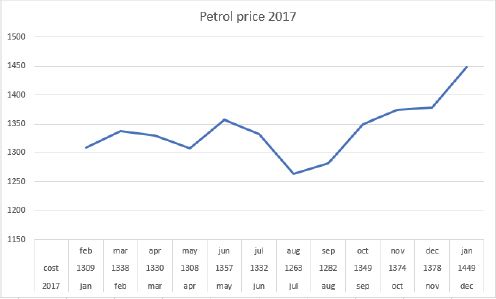
A.The price of petrol in 2018
B.The components of petrol
C.The trend of petrol prices during the year
D.The amount of petrol produced in 2017
1.3Which of the following is the last step of the information management process? (1)
A.Presenting information
B.Collecting data
C.Processing a database
D.Analysing results
1.4When evaluating a website, which of the following questions must not be asked? (1)
A.Who supports this website?
B.Who is this website aimed at?
C.Which year was the website established?
D.Who is the author?
1.5When evaluating information, which of the following must not be determined? (1)
A.Authority
B.Accuracy
C.Objectivity
D.Consistency
QUESTION 2: TRUE OR FALSE
Choose the answer and write True or False next to the question number. Correct the statement if it is FALSE. Change the underlined word(s) to make the statement TRUE. (You may not simply use the word NOT to change the statement.)
a.Spreadsheets store their data on a server. (1)
b.Databases are able to perform complex calculations on small amounts of data. (1)
c.Analysis is the first step of the information management process. (1)
d.Surveys and questionnaires can be electronic. (1)
e.If a website does not have the name of the author, it is a good website. (1)
QUESTION 3: CATEGORISATION QUESTIONS
3.1Which of the following situations would use a database or spreadsheet? (3)
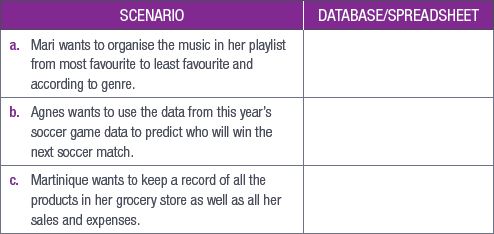
3.2Which of the following types of graph would best represent the following scenario? (3)
A.Bar graph
B.Line graph
C.Histogram
D.Pie chart

QUESTION 4: SHORT QUESTIONS
4.1List two tools you can use to gather data. (2)
4.2What is the difference between a trend and a pattern? (2)
4.3Why should you avoid questions that start with “Why”? Also mention how you can prevent this. (2)
QUESTION 5: SCENARIO-BASED QUESTIONS
In order to lose weight and become healthier, Greg decided to start jogging so that he could run in different marathons. Each year Greg recorded how many kilometres he ran. Look at the following graph and answer the questions that follow.
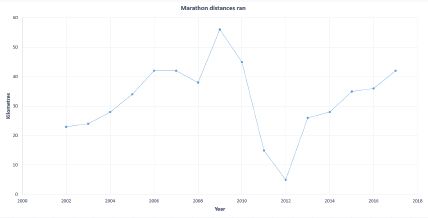
5.1What type of graph is this? (1)
5.2Does this graph represent data or information? Give an explanation for your answer. (2)
5.3According to this graph, when did Greg run the longest distance? (1)
5.4What is the trend from 2002 to 2009? (1)
5.5Mention two things that this trend indicates about Greg’s health. (2)
5.6Greg badly injured his ankle during a marathon and was advised by the doctor not to run for the next year. According to this graph, in which year did this injury occur? (1)
Nomfundo had to do research on the different phone brands on sale at the Innovation Tech store. While doing this she found that they sold the following brands:
- Samsung
- Apple
- Nokia
- Blackberry
- Huawei
- LG
Now Nomfundo wants to use this information to figure out what the most popular phone brands are at her school so she can know if it would be a good idea to promote this store at her school.
5.7Based on this scenario, identify the two problems Nomfundo must solve. (2)
5.8What information-gathering method Nomfundo can use to solve this problem? Give a reason for why she should use this method, and a reason for why she cannot use the other two methods. (4)
5.9What two tips would you give Nomfundo about creating questions? (2)
5.10 Create two questions that Nomfundo can ask her school peers to find the information she needs. (2)
TOTAL: [40]
AT THE END OF THE CHAPTER
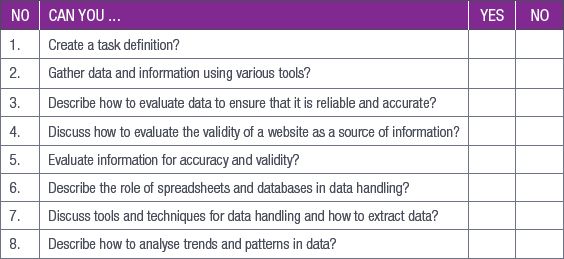
|
Previous
Chapter 12: E-communications
|
Table of Contents |

